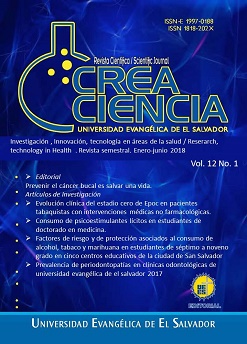Consumption of licit psychostimulants in PhD students in Medicine
DOI:
https://doi.org/10.5377/creaciencia.v12i1.8058Keywords:
Energy drink, Coffee, Nicotine, Tobacco, Legal use, El SalvadorAbstract
Introduction: Academic and hospital activities lead medical students to the consumption of psychostimulant substances of common use, in order to increase their motor and cognitive activity, but the legal nature of these products does not exclude them from having adverse effects if consume in inadequate amounts.
Objective: To know the consumption of licit psychostimulants substances commonly used in students of the Doctorate in Medicine clinical area of the Universidad Evangélica de El Salvador.
Method: Study with quantitative approach, deductive method, descriptive and transversal type, in students of the clinical area of Doctorate in Medicine of the Universidad Evangélica de El Salvador of the cycle 1-2017, population of 374 students and sample of 190, random and proportional.
Results: Almost 70% reported making use of psychostimulants, of which 90% reported coffee as the main psychostimulant consumed and one in four people interviewed use tobacco or energy drinks.
The licit psychostimulant with the highest inadequate consumption is tobacco 23.3%.
Conclusions: The licit psychostimulants of common use used by Doctoral students in Medicine in the clinical area: coffee, tobacco, energy drinks and cola drinks.
The general consumption of psychostimulants in medical students is within the parameters of consumption in Latin America. The products that presented inadequate consumption were coffee and tobacco.
The number of medical students dependent on tobacco increases as they advance in the clinical area, despite this, the percentage of UEES medicine students who smoke is almost half of the prevalence of smoking in young Latin Americans.
Downloads
1642
Downloads
Published
How to Cite
Issue
Section
License
© Crea Ciencia
Declaration of originality and assignment of rights
The article must be sent with a declaration of originality, responsibility and assignment of rights of copy of the manuscript, scanned and signed by the author or by one of the authors when the authorship is collective (designated author), stating that the text has not previously published in printed or electronic format, which will not be presented to any other media before knowing the decision of the journal Crea Ciencia and that, if accepted for publication, the authors transfer the copyrights in all forms and media known. At the end of six months of the publication, the text can be shared in another magazine citing the first version of the article published in Crea Ciencia and recording its number and volume. If the article is not published, the UEES agrees to return the rights enunciated to their authors.

Crea Ciencia articles are published in open access and licensed under a Creative Commons Attribution-NonCommercial 4.0 International License.

